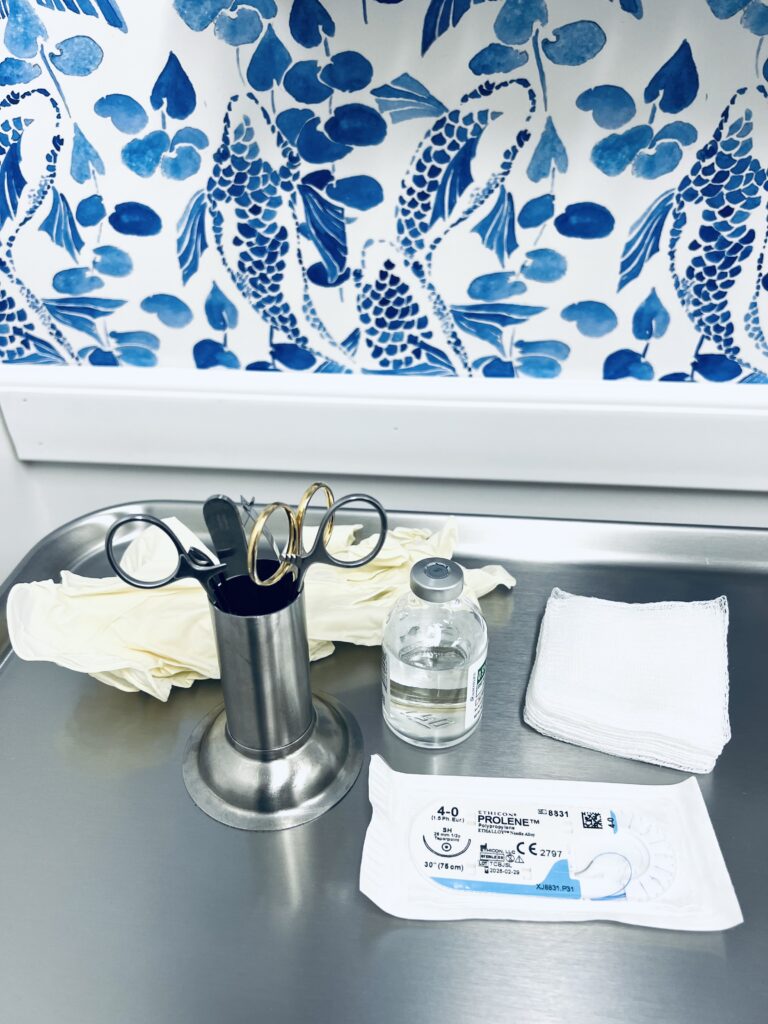
Find Peace of Mind Today
Skin Cancer Excision and Reconstruction
Are you concerned about skin cancer? Do you want to know more about the causes and treatments available? Brevard Cosmetics offers comprehensive excision and reconstruction procedures to help with the hazards of skin cancer.

Remove Skin Cancer Now
Skin Cancer Excision and Reconstruction is a surgical procedure to remove skin cancer lesions, such as melanoma or basal cell carcinoma while preserving the surrounding healthy tissues. The goal is to ensure the complete removal of the tumor while minimizing any scarring or disfigurement caused by the surgery.

Benefits of Skin Cancer Excision and Reconstruction
- There are several benefits to having a Skin Cancer Excision and Reconstruction:
- Reduces the risk of skin cancer recurring
- Removes the cancer
- Improves the cosmetic appearance of the affected area
- Optimizes the cosmetic appearance of the affected area
If reconstruction is required with a graft or a flap, Dr. Bashore is highly trained and experienced in these procedures allowing for the best possible outcomes.
Types of Skin Cancer
BCC (Basal Cell Carcinoma)
Basal cell carcinoma is the most common form of skin cancer. It is caused by a mutation in the basal cells of the epidermis, which are responsible for producing new cells. Most cases of BCC are slow-growing and can be successfully treated with surgery or other treatments such as radiation therapy or cryotherapy.
SCC (Squamous Cell Carcinoma)
Squamous cell carcinoma is a form of skin cancer that affects the squamous cells in the epidermis and is usually caused by exposure to ultraviolet radiation from sunlight or tanning beds. It may appear as red, scaly patches on the skin or may even present as a lump or ulcer. Treatment for this form of skin cancer often includes surgery, radiation therapy, or chemotherapy.
Melanoma
Melanoma is the most dangerous form of skin cancer and can spread quickly if not caught early. It is caused by an abnormality in the melanocytes, which are the cells in the skin that produce melanin, or dark pigment. Common signs of melanoma include changes to existing moles or the development of new moles on the body. Treatment for this form of skin cancer can involve surgery, radiation therapy, chemotherapy, or immunotherapy.
What Types of Skin Cancer Excision and Reconstruction Are Available?
There are many different types of Skin Cancer Excision and Reconstruction procedures.
Local Excision
Depending on the size and location of the tumor, your doctor may opt for a simple Local Excision, where only the tumor is removed.
Wide Excision
In more complex cases, they may recommend a Wide Excision to remove the entire lesion as well as some surrounding healthy tissue.
To reconstruct the area, they may use one of several types of cartilage grafts or skin flaps. A skin graft involves transferring a piece of healthy skin from another area of your body. A flap is created by moving tissue from one location to another.
What Should You Expect From Skin Cancer Excision and Reconstruction?
These procedures are typically done under general or local anesthesia, depending on the size of the lesion. The surgeon will cut out the cancerous lesion, and if necessary, reconstruct the area with skin from another location. Reconstruction may include placing skin grafts or local flaps over the affected area to reduce scarring.
Typically following local flap repair of a skin cancer defect, sutures will remain in place for up to one week and be removed in the office at follow-up. After surgery, you may experience pain or discomfort in the affected area. Your doctor may also prescribe you antibiotics to reduce the risk of infection and advise you on how to care for the reconstructed area.
Lorem ipsum dolor amet, consectetur adipiscing elit
Lorem ipsum dolor amet, consectetur adipiscing elit
Lorem ipsum dolor amet, consectetur adipiscing elit
Lorem ipsum dolor amet, consectetur adipiscing elit
Everything You Need to Know About Recovery
Recovery from a Skin Cancer Excision and Reconstruction procedure typically takes several weeks. During this time, it is important to follow all your doctor’s post-operative instructions. Additionally, you should avoid strenuous activities that could disrupt the healing process. With proper care, most patients return to their normal activities within a few weeks.

Why Choose Brevard Cosmetic Surgery Group for Skin Cancer Excision and Reconstruction?
BCSG is dedicated to providing the highest quality care and results possible.Our team has extensive experience with this type of procedure. You can rest assured knowing you will have a comfortable, safe, and personalized experience.
Commonly Asked Questions About
Skin Cancer Excision and Reconstruction

Schedule a Skin Cancer Excision and Reconstruction Consultation Today
with Brevard Cosmetic Surgery Group
If you have been diagnosed with skin cancer and would like to learn more about your treatment options, contact BCSG today. Our team of highly trained professionals is here to help you understand the risks and benefits, as well as answer any questions you may have.
Other Face Procedures
Please see below for our specialty services

Facelift
A Facelift, or Rhytidectomy, is a reconstructive surgery that can help reduce the signs of aging in your face and neck, such as fine lines, frown lines, and creases. Through incisions made along the hairline, excess skin and fatty tissue are removed and the underlying muscles are tightened. This procedure aims to give you a more youthful-looking appearance by smoothing wrinkles and sagging jowls.

Mini Facelift
A Mini Facelift, also known as a Short Scar Facelift, is similar to a traditional Facelift but with fewer incisions. This procedure targets the lower third of the face and neck, making it an ideal choice if you want to reduce wrinkles around the mouth and minimize jowls.

Neck Lift
A Neck Lift, or lower Rhytidectomy, is a surgical procedure that can help reduce double-chin, sagging, and looseness of the skin in the neck area. Through incisions made along the hairline, excess fat and tissue are removed and underlying muscles are tightened to give you a smoother, more contoured jawline.

Rhinoplasty
Rhinoplasty, or a Nose Job, is a nose surgery used to improve the shape and size of your nose. Through incisions made on either side of your nostrils, cartilage and/or bone can be reshaped to give you a more proportionate nasal profile. The goal of this procedure is to improve breathing, improve the appearance of your nose, or both.

Blepharoplasty
Blepharoplasty, or Eyelid Surgery, is a surgical procedure that can help reduce crow’s feet, wrinkles, and sagging skin in the eye area. Through small incisions made along the eyelids, excess fat and tissue are removed.

Upper Eyelid Surgery
Upper Eyelid Surgery is done to reduce sagging and wrinkled skin in the upper eyelids. Through small incisions made along the eyelids, excess fat and tissue are removed and underlying muscles are tightened to give you a more alert and refreshed look.

Lower Eyelid Surgery
Lower Eyelid Surgery is done to reduce sagging and wrinkles in the lower eyelids. Through small incisions made along the eyelids, excess fat and tissue are removed and underlying muscles are tightened to give you a more youthful-looking appearance.

Otoplasty
Otoplasty, or Ear Surgery, is a surgical procedure used to improve the shape and size of your ears. Through incisions made behind the ear folds, cartilage can be reshaped, and/or excess skin may be removed. The goal of this procedure is to give you a more natural, proportionate appearance.

Chin/Neck Liposuction
Submental Liposuction is a surgical procedure to reduce unwanted fat deposits in the face. Through small incisions made near the target treatment area, excess fat is removed and underlying muscles are tightened. The goal of this procedure is to give you a more contoured look.